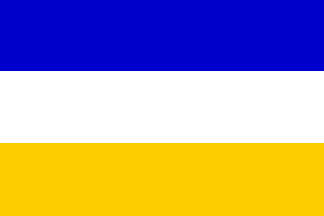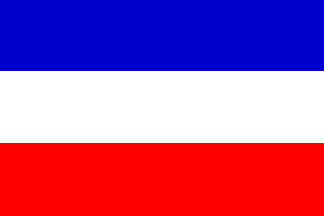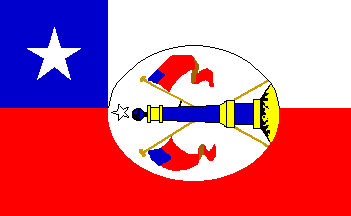
Last modified: 2006-09-30 by antónio martins
Keywords: independence | stars and stripes | patria vieja | reconquista | transition | transición | patria nueva |
Links: FOTW homepage |
search |
disclaimer and copyright |
write us |
mirrors

Bandera de la Patria Vieja, used during the Chilean “Old
Motherland” period, before 1814.
Francisco Gregoric, 16 Jul 2004
From the Cabildo Abierto of September 1810 until the
defeat of patriot forces at Rancagua in September of 1814, the
Chilean colony enjoyed a period of home rule that Chilean
historigraphy calls La Patria Vieja
Ned Smith, 07 Sep 1999
Flag called the Old Country: blue on white on yellow. I believe
that it was used in the first independence from 1810 to 1814.
Jaume Ollé 12 Jun 1996
The adoption of both a flag and an emblem to distinguish the patriots was
suggested by Jose Miguel Carrera. This consisted of three stripes, white,
blue and yellow and was adopted with solemnity on 30 September 1812, bearing
the coat-of-arms of the Old Fatherland. This flag did not survive and was
waved for the last time at the Battle of Rancagua (1814).
Dov Gutterman, 05 Sep 1999,
quoting from
http://www.echileuk.demon.co.uk/band_ing.htm
The design of the Mapuche-Tehelche flag is
certainly the same design of the first Chilean flag. The reason why it is
used by native American groups is that apparently the design would have
been used by some native American tribes in late 19 Century. In those times
the tribes used to move freely from one side of the Andes to theother. It
is possible that in that moment, someone from Chile gave them the idea to
use that historical Chilean flag.
Francisco Gregoric, 16 Jul 2004
The 1812 arms are created also by Carreras and show two natives, a column,
a earth gloobe, and crossed palm and lance. The moto is «Post tenebras
lux» (light — independence? — after darkness —
spanish rule?). The better image that I know can be found in the printed
reedition of my Bulletin, issue 6 [frp]. Was
provided with an heraldist from Chile.
Jaume Ollé, 12 Sep 1999
During this period the relevant
spanish flags were used.
António Martins, 29 Sep 2006

The flag of 1810 was substituted by a similar design in which the
yellow stripe was replaced by a red stripe. This flag was called
Transition and it was used by the revolutionary troops between 1816
and 1817.
Jaume Ollé 12 Jun 1996
After the Battle of Chacabuco (1817) a so called “transition”
flag was created, having three horizontal stripes, blue, white and red. The
designed was attributed to Juan Gregorio de las Heras. However, this flag as
the Old Fatherland’s did not have the official
recognition and it soon dissapear. This transition flag was also abolished
because it was easily confused with the Dutch flag,
among other reasons.
Dov Gutterman, 05 Sep 1999,
quoting from
http://www.echileuk.demon.co.uk/band_ing.htm

In 1817 an American that was serving in the rebel army designed a
flag with American reminescences, that was very similar to the
current flag of Chile. In the center was sewn
the national shield.
Adopted by the rebel army in 1817, it was used to swear the Chilean
independence February 12, 1818.
Jaume Ollé 12 Jun 1996
The present flag was created by Minister Jose Ignacio Zenteno
and designed by Antonio Arcos, a Spanish military, although some would
sustain that it was Gregorio de Andia y Varela who designed it. It was
established on 18 October 1817 under the Government of the Supreme Director,
Captain General Bernardo O’Higgins through a decree of the Ministry of War
headed by Secretary of State, Colonel José Ignacio Zenteno. The decree is
only known by indirect reference as the original copy was never found. The
national flag was used publicly for the first time on 12 February 1818,
during the official proclamation of the Independence and the swearing
ceremony of the flag, and it was carried by Colonel Tomas Guido.
Dov Gutterman, 05 Sep 1999,
quoting from
http://www.echileuk.demon.co.uk/band_ing.htm
The book [c9l97] depicts an
excellent image of the less know national arms of 1819-1834.
Jaume Ollé, 12 Jun 2002
Anything below this line was not added by the editor of this page.